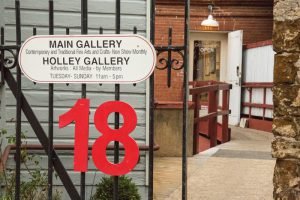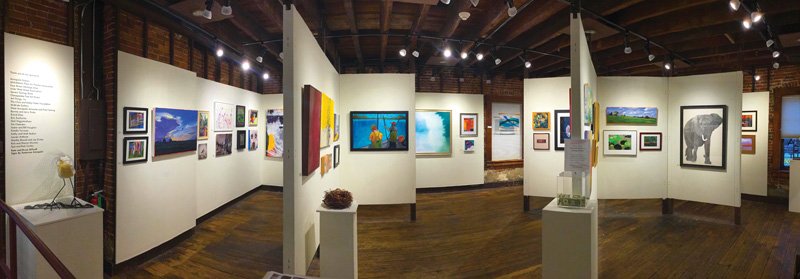+ By Brenda Wintrode
If one were trying to hide in plain sight, like a hobbit carving a home inside the cozy hollow of a tree, the building at 18 State Circle would provide such a service. A sign hangs on the iron gate for the Maryland Federation of the Arts’ (MFA’s) Circle Gallery, pointing out the path that leads to its entrance. It feels private, and I am unsure whether or not I should knock. The familiar earthy smell of brick and mortar greets me as I walk through the door. Once inside, I set eyes upon the unassuming display space, feeling that I have just discovered a hidden treasure. My introduction to this alcove of artistry is blissful, and I start planning my next visit.
 Less is more, there. Simple half-faux walls and track lighting through the middle of the main gallery and along the walls modernize the space just enough to highlight the room’s focal point: MFA members’ artwork. Exposed brick walls, less perfect than they perhaps once were, enclose the room and provide a neutral backdrop for various expressions of the current show’s theme, American Landscapes. Farm buildings and silos, grasses, and birds grace the canvas through oil paint applied by artist David Diaz. Kathleen Bennet Dove entered a humorous, perhaps ironic photograph of a pod of pelicans sitting on a dock above a sign that says, “Keep Off Dock.” A mixed media work by Eloa Jane Pereira titled “The Solitary Tree in Arkansas Bluff” uses recycled, rolled paper, and acrylic paint to create a textured landscape. I linger in front of each composition and still frame.
Less is more, there. Simple half-faux walls and track lighting through the middle of the main gallery and along the walls modernize the space just enough to highlight the room’s focal point: MFA members’ artwork. Exposed brick walls, less perfect than they perhaps once were, enclose the room and provide a neutral backdrop for various expressions of the current show’s theme, American Landscapes. Farm buildings and silos, grasses, and birds grace the canvas through oil paint applied by artist David Diaz. Kathleen Bennet Dove entered a humorous, perhaps ironic photograph of a pod of pelicans sitting on a dock above a sign that says, “Keep Off Dock.” A mixed media work by Eloa Jane Pereira titled “The Solitary Tree in Arkansas Bluff” uses recycled, rolled paper, and acrylic paint to create a textured landscape. I linger in front of each composition and still frame.
More than art is on display in the MFA’s space. The interior, the bones of the building itself, reveals a builder’s artistry from over 170 years ago and its natural, inevitable decay. It has withstood time, restoration, and decades of repurposing, to great effect. Original square-head iron nails fasten six-inch trim boards around the room’s six double-hung windows. Wood grains the color of tar streak the ashen gray-brown original wood floors. I expected them to creak under my weight. Wide beam rafters stripe the ceiling, adding even more character.
The building’s first owner, Thomas Franklin, was a former cashier at Farmer’s National Bank and used the building as a general store. A pulley system hung from the attic rafters and transferred goods between the second and first floors; the hole between the levels has since been covered. Franklin bequeathed the property to family members until 1902, when it was purchased by the Benevolent and Protective Order of Elks. The State of Maryland has owned it since 1961, and rents out the top and bottom floors. In 2018, the MFA will have occupied the upstairs area for 50 years.
 If the state’s primary interest in owning the property were for historical preservation, it would likely have made a sound investment. According to a Maryland Historical Trust building survey document published in 1964 by Harley J. McKee and recorded by William D. Morgan of Columbia University, the property is a “superb building and a real architectural gem. One of the most consciously Greek buildings in Annapolis.” Greek Revival temple style was popular in the mid to 1800s. Those elements are best viewed from the exterior facade at 206 Main Street, where the first floor currently houses The Alpaca Store, where two Doric-style pilasters lie at the outer edges of the building’s Main Street facade. The southern facade defines one wall of the landmark Chancery Row, a famous vantage point for a great picture of the Maryland State House dome.
If the state’s primary interest in owning the property were for historical preservation, it would likely have made a sound investment. According to a Maryland Historical Trust building survey document published in 1964 by Harley J. McKee and recorded by William D. Morgan of Columbia University, the property is a “superb building and a real architectural gem. One of the most consciously Greek buildings in Annapolis.” Greek Revival temple style was popular in the mid to 1800s. Those elements are best viewed from the exterior facade at 206 Main Street, where the first floor currently houses The Alpaca Store, where two Doric-style pilasters lie at the outer edges of the building’s Main Street facade. The southern facade defines one wall of the landmark Chancery Row, a famous vantage point for a great picture of the Maryland State House dome.
Small Wonders is the next juried show presented by the MFA at Circle Gallery and will be on display through December 23. Each entry must be no larger than eleven inches in height, width, and depth. The number of pieces on display in the gallery will double for the annual show, from the typical 80 works to 160. In the 600-square-foot gallery space, the curators will ensure that each entry is placed in the best light. Small wonder, indeed. █








